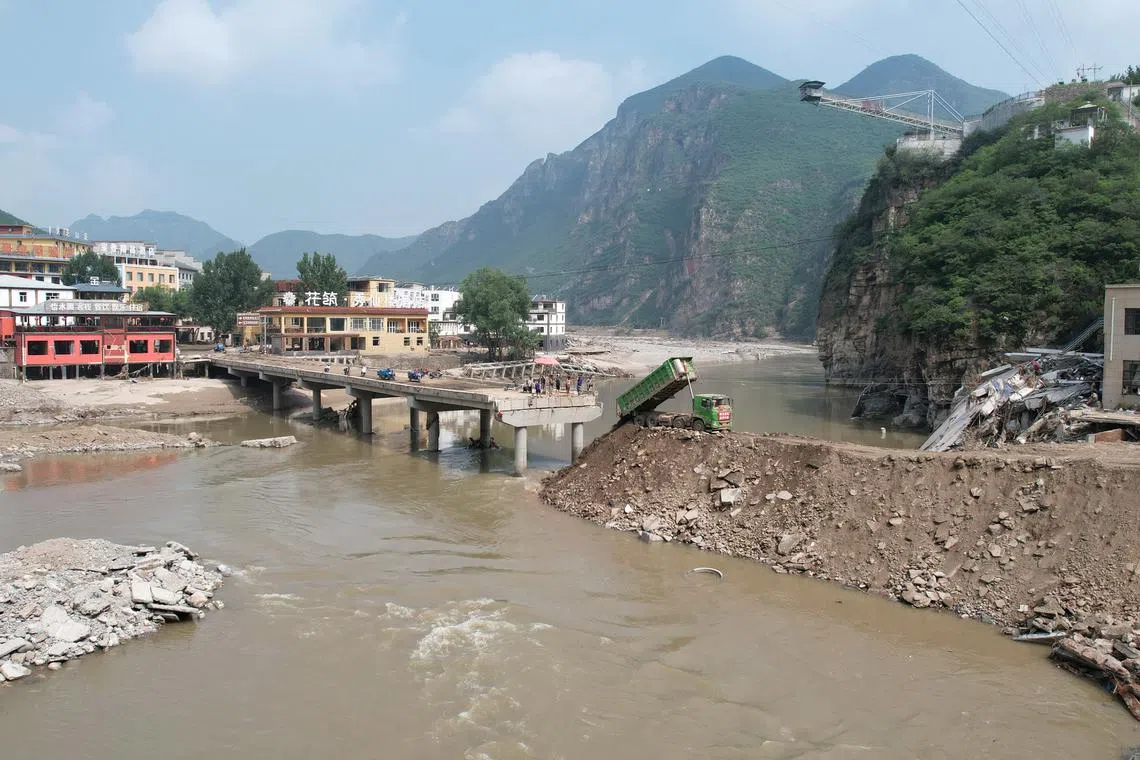China’s death toll from heavy rains rises to 78 as new storm approaches
Sign up now: Get insights on Asia's fast-moving developments

China’s northern Hebei province upgraded its emergency response to the highest level following record flooding last week.
PHOTO: EPA-EFE
Follow topic:
BEIJING - The death toll from record-breaking rain across northern China rose to at least 78 on Friday, as the authorities warned of more flooding and another storm approaches.
Deaths from flooding in China’s northern Hebei province rose to 29, state media reported on Friday, after Tropical Storm Doksuri, which hit mainland China as a typhoon two weeks ago, brought on the most severe rainfall since records began 140 years ago.
Rescuers have continued to search for people swept away by the floods, as another storm, Khanun, is set to make landfall over the weekend.
The deluge followed weeks of historic heat, with scientists saying such extreme weather events are being exacerbated by climate change.
Streets in parts of Hebei, which borders the capital Beijing, were still caked in mud when reporters visited on Wednesday.
Residents were scrambling to recover waterlogged belongings and clean up damaged homes.
During a visit to affected communities last week, Hebei province party chief Ni Yuefeng said the area could “reduce the pressure on Beijing’s flood control” and serve as a “moat” for the capital.
As at Thursday, 29 people had been killed by the rains across the province, six of whom had been previously listed as missing, state broadcaster CCTV said on Friday. Sixteen are still missing.
In Beijing, at least 33 people have died, including two rescue workers, the authorities said this week. And more than a dozen people were killed in north-eastern Jilin province after torrential rain last week.
Heavy rain is expected again over the weekend as Khanun approaches China.
Khanun has already battered parts of Japan and the Korean peninsula.
Since late July, China’s north and north-east have been struck by widespread flooding triggered by record rainfall in the wake of Doksuri.
Hebei, part of the Haihe River basin, northern China’s largest, was lashed by more than a year’s rainfall the week before, forcing the evacuation of more than 1.6 million people.
At a video conference studying the current situation, flood control authorities warned against “slacking” in strengthening inspection of flood channels and key levees, the state media reported.
They called for faster repair and restoration of key infrastructure and homes so that the lives of people can return to normal. China’s Cabinet on Tuesday said it would return flood victims to their homes by winter.
Khanun, forecast to enter China from its north-east on Saturday, was set to bring heavy rainfall in north-eastern Jilin and Heilongjiang provinces as soon as Friday.
The rain will heighten flooding risk in the south-eastern parts of Heilongjiang, where water levels are already high and its soil saturated following the previous round of rainfall, according to the official Xinhua news agency.
Many rivers in the Songhua basin spanning north-eastern China remained swollen as at Thursday.
In other parts of China not directly affected by Khanun, such as Gansu and Qinghai in the north-west and Yunnan and Sichuan in the south-west, the authorities renewed warnings of flash floods in an unusually wet summer in China. REUTERS, AFP

